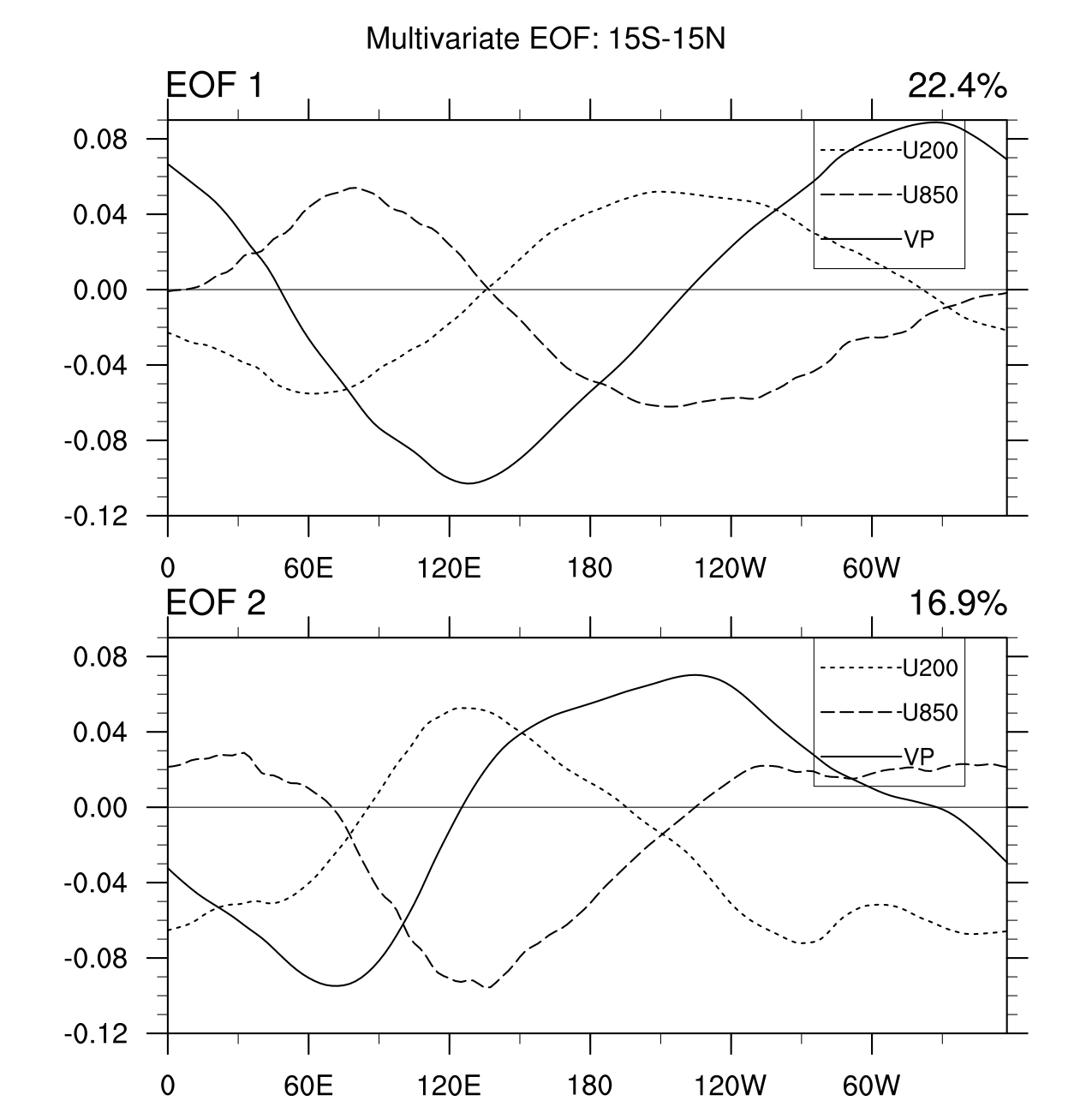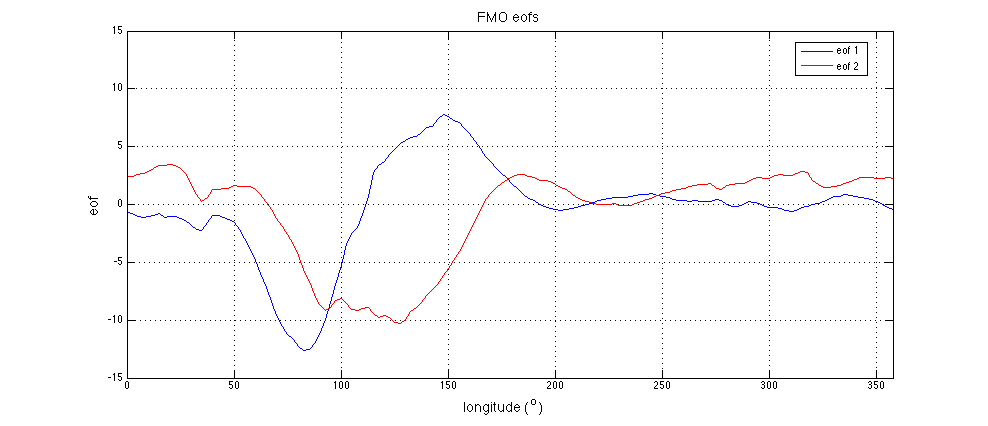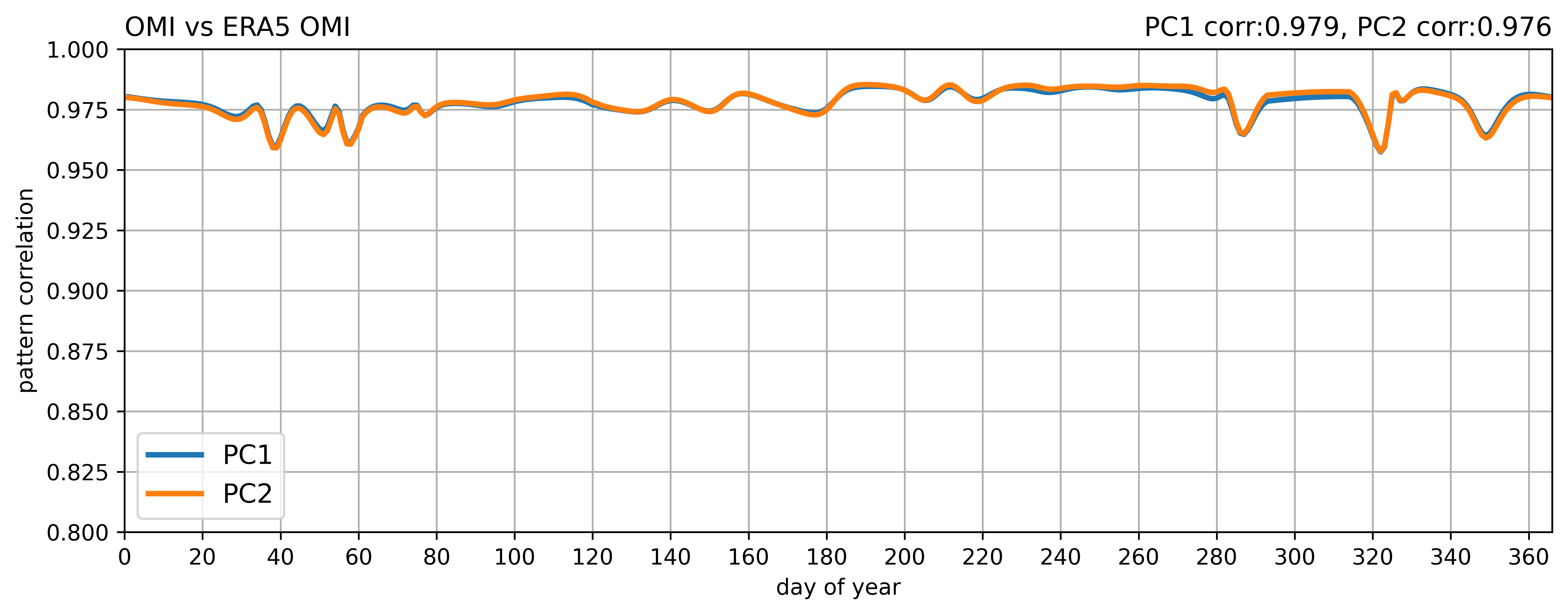Daily Timeseries | Composite Maps | Animations | ASCII EOF's | Other MJO Indices and Information
PSL is creating a set of MJO timeseries that quantify current and historic MJO activity.
The links and descriptions are below as well as links to some other MJO timeseries created at other institutions.
A description of the timeseries format is available.
NOTE: ROMI is now provided in near real-time.
The OMI has been updated through May 20 2024. These PC amplitudes will differ slightly from the previous
version since the sample used for the 20-96 day filter is longer (1979-2021), resulting in slightly different values for the
filtered OLR used to calculate OMI. In some cases this may also result in a phase difference (by one phase) from the previous
versions. The EOFs used are still from 1979-2012 (see below).
The previous (1979-2021) version of OMI can be obtained here.
NOTE: When comparing OMI directly with RMM, to obtain the proper phase the sign of OMI PC1 and the PC
ordering should be reversed, so that OMI(PC2) is analogous to RMM(PC1) and -OMI(PC1) is analogous to RMM (PC2).
Daily MJO index time series from 1979
| Index | Description | Obtain timeseries |
ERA5 OMI
The ERA5 OLR MJO Index | Projection of 20-96 day filtered ERA5 OLR, including all eastward and westward wave numbers onto the daily spatial EOF patterns of 30-96 day eastward filtered OLR from the ERA5 dataset. EOFs are calculated using data from 1940 to "present". | ERA5 OMI values |
OMI
The OLR MJO Index | Projection of 20-96 day filtered OLR, including all eastward and westward wave numbers onto the daily spatial EOF patterns of 30-96 day eastward filtered OLR. | OMI values |
OOMI
The Original OLR MJO Index | Projection of 30-96 day eastward only filtered OLR onto the spatial EOF patterns of
30-96 day eastward filtered OLR. This results in a smoother index than OMI due to more restrictive filtering. | OOMI values |
ROMI
The Real-time OLR MJO Index | Projection of 9 day running average OLR anomalies onto the daily spatial EOF patterns of 30-96 day eastward filtered OLR. OLR anomalies are calculated by first subtracting the previous 40 day mean OLR. The running average is tapered as the target date is approached. | ROMI values |
FMO
The Filtered OLR MJO index. | Univariate EOF of normalized 20-96 day filtered OLR averaged from 15S-15N, by longitude. The same spatial EOF pattern is used for the entire year (see below). | FMO values. |
VPM
The Velocity Potential MJO index. | Calculated in the same way as the Wheeler-Hendon RMM, except using 200 hPa Velocity Potential instead of OLR, along with U200 and U850 in a combined EOF (see link to Ventrice et al. 2013 below). | VPM values |
RMII
The realtime Multivariate Index for tropical Intraseasonal oscillations. | Projection of 9 day running average anomalies onto the daily spatial multivariate EOFs of 20-96 day eastward filtered OLR, U850 and U200. Anomalies are calculated by first subtracting the previous 40 day mean. The running average is tapered as the target date is approached. | RMII values |
REOMI
The Rotated EOFs OLR Madden Julian Index. | Projection of 20-96 day filtered OLR, including all eastward and westward wave numbers onto the rotated daily spatial EOF patterns of 30-96 day eastward filtered OLR. EOFs are calculated using OLR from 1979-2012. PCs are calculated from 1979-2022. EOFs are rotated to reduce noise and potential degeneracy issues as detailed in Weidman et al., 2022. | REOMI values |
KRMM
The Koopman Real-time MultiVariate Madden Julian Index | Calculated following the Wheeler-Hendon RMM, but using Koopman spectral analysis to compute eigenfunctions. The leading mode of intraseasonal variability is rotated to maximize correlation with the standard RMM. See link to Lintner et al. 2023 for further discussion of the Koopman spectral analysis and methodological details. | KRMM values |
A python routine to calculate the OMI has been developed for use on real-time and model data, and can be accessed via GitHub at: https://github.com/cghoffmann/mjoindices and also at Zenodo: https://doi.org/10.5281/zenodo.3613752. For the REOMI, code is in the same repository. using the parameter eofs_postprocessing_type="eof_rotation" in the main method for calculating EOFs: omi.omi_calculator.calc_eofs_from_olr(). No other changes should be necessary from the standard OMI calculation.
Details of the implementation of this software are outlined in the journal article:
Hoffmann CG, Kiladis GN, Gehne M, von Savigny C 2021 A Python Package to Calculate the OLR-Based Index of the Madden-Julian-Oscillation (OMI) in Climate Science and Weather Forecasting. Journal of Open Research Software, 9:9. DOI: https://doi.org/10.5334/jors.331/ (PDF)
The ERA5 based OMI was computed using the python package by: Hoffmann CG, Kiladis GN, Gehne M, von Savigny C 2021
A Python Package to Calculate the OLR-Based Index of the Madden-Julian-Oscillation (OMI) in Climate Science and Weather Forecasting. Journal of Open Research Software, 9:9. DOI: https://doi.org/10.5334/jors.331.
The EOFs for the ERA5 based OMI were computed using data from 1940-2023. Using the years 1979-2018 to compute ERA5 EOFs gives good agreement with the
observed OMI EOFs in terms of spatial correlation (see below). The EOFs for the time period 1940-2023 have less agreement, but still a pattern correlation above 0.9
for most of the year.
The rMII code and MII values are available upon request from the lead author (Shuguang Wang: wangsg@outlook.com).
For more information for all indices other than the VPM and rMII, please read the article "A comparison of OLR and circulation based indices for tracking the MJO". We ask that if you use the timeseries in you research that, please cite that paper, e.g.:
For the VPM, please cite:
For the rMII, please cite
Wang et al: Multivariate Index for Tropical Intraseasonal Oscillations Based on the Seasonally-Varying Modal Structures: JGR Atmospheres, Feb 2022, Vol 127, pp 1-19.
https://doi.org/10.1029/2021JD035961.
Lintner, B. R., D. Giannakis, M. Pike, J. Slawinska (2023). Identification of the Madden–Julian Oscillation with data-driven Koopman spectral analysis. Geophys. Res. Lett., 50, e2023GL102743.
https://doi.org/doi.org/10.1029/2023GL102743. (copy is
here)
Python routines to calculate OMI
MATLAB routines to calculate KRMM
Composite streamfunction and OLR patterns for RMM and OMI based on the events that exceed 1 standard deviation for each phase of the PC combination.
These are based on data from 1979 through 2012, and the number of events in each composite is given as "N= " at the bottom of each plot. Blue shading denotes negative OLR anomalies
(regions of convection) and red positive (suppressed), with two levels of shading at +- 10 and +- 6 W/m**2. Streamfunction contour interval is 5 X 10**5 m**2/s at 200 hPa, and 2 X 10**5 m**2/s
at 850 hPa. To facilitate comparison with RMM, these composites are constructed by reversing the sign of
OMI PC1 and the OMI PC ordering, so that OMI(PC2) is analogous to
RMM(PC1) and -OMI(PC1) is analogous to RMM(PC2), as described in
Kiladis et al. 2014.
- 200mb OMI DJF
- 200mb OMI JJA
- 200mb RMM DJF
- 200mb RMM JJA
- 850mb OMI DJF
- 850mb OMI JJA
- 850mb RMM DJF
- 850mb RMM JJA
MJO EOF Patterns
OMI EOF patterns.
- The ASCII EOF values are available via ftp/downloads for EOF1 and EOF2 . They can be read using the code read.eof.f. User can retrieve the files via the web or using an (anonymous) ftp client at the address ftp2.psl.noaa.gov. Then, cd to /Datasets.other/MJO/.
OMI EOF Animations
VPM EOF patterns.
- The VPM EOFs are computed using zonal wind and velocity potential based on NCEP reanalysis version 1 from 1979 to 2012.

FMO EOF patterns.
- The ASCII FMO EOF values are available from here.
| FMO Spatial EOFs |  |
Comparison of OMI EOFs from ERA5 vs Observed OLR
Pattern correlation between observed OMI EOFs from 1979-2012 and ERA5 OMI EOFs from 1979-2018 for each
day of the year. EOF patterns are correlated at 0.95 or above and PC time series are correlated at above 0.97 and are deemed
sufficiently similar. The ERA5 based OMI was computed using the python package by: Hoffmann CG, Kiladis GN, Gehne M, von Savigny C 2021
A Python Package to Calculate the OLR-Based Index of the Madden-Julian-Oscillation (OMI) in Climate Science and Weather Forecasting. Journal of Open Research Software, 9:9. DOI: https://doi.org/10.5334/jors.331/ (PDF).
Other MJO indices





